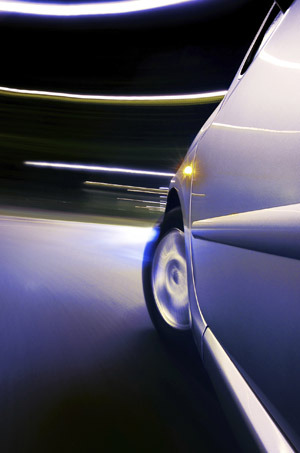Driving safely at night
Crash risks while driving at night are higher than during the daytime, but most roadways in the US do not have roadway lighting. In fact, many state and local governments find it difficult to pay for installing, operating and maintaining roadway lighting. Despite these concerns, the proportion of night-time driving is not likely to go down in today's round-the-clock economy, making car headlights increasingly important to night-time driving safety.
Through its Transportation Lighting and Safety program, the Lighting Research Center (LRC) at Rensselaer Polytechnic Institute is evaluating the potential for new lighting technologies and approaches to improve driving safety at night, including new car headlight systems.

Senior Research Scientist and Adjunct Assistant Professor John Bullough presented recent LRC research results at two international conferences dedicated to driving, vision, lighting and safety. At the International Symposium on Automotive Lighting, held 23-25 September in Darmstadt, Germany, Bullough presented a paper entitled ‘Applying visual performance modeling to adaptive curve lighting safety data’, looking at swivelling or bending headlights that direct light into roadway curves. Visibility analyses from LRC field studies using these systems in comparison with conventional, stationary low-beam headlights led to estimates of reduced night-time crash frequencies of almost 4% along low-speed, sharp roadway curves and between 1 and 2% along higher-speed, shallower curves.
Earlier, at the Detroit Institute of Ophthalmology's The Eye, The Brain and The Auto research congress held in Dearborn, Michigan from 16-18 September, Bullough presented ‘Adaptive vehicle lighting, visual performance and safety’, a look at the potential safety benefits of adaptive or glare-free high-beam headlight systems, which are beginning to appear on international vehicle models. These systems allow drivers to use high-beam headlights while selectively dimming a portion of the beam when oncoming drivers are present, which prevents glare to the oncoming drivers while providing improved visibility along the rest of the road. The LRC’s analyses suggest that night-time crashes might be reduced by nearly 7% when adaptive high beams are used, relative to using low-beam headlights.
The basis for both studies was the relative visual performance (RVP) model developed by LRC Director Mark Rea. Bullough and Rea previously showed that the safety benefits from roadway intersection lighting were in line with visibility improvements evaluated using the RVP model for different types of intersections. According to Bullough, “Since visual performance for night-time driving situations can be predicted accurately, and night-time crash data are difficult to collect, RVP could serve as a practical surrogate for crashes, allowing us to efficiently identify new lighting systems for maximising driving safety at night.”
Both studies were sponsored by the Transportation Lighting Alliance (TLA), consisting of vehicle and lighting manufacturers Audi, Automotive Lighting, Hella, OSRAM SYLVANIA, Philips and Varroc Lighting.
Rock lobster processor and exporter finds driver safety partner
A transport technology solutions provider has announced a new contract to enhance safety with...
Level crossing AI safety solution has merit
Among the merit recipients in the 2025 VIC iAwards was an edge AI solution designed to enhance...
Laser bird deterrent boosts tram depot safety
A Melbourne tram depot has reduced bird roosting by 90%, boosting safety through a fully...








